When it comes to motorcycle belt replacement, it's vital you understand how the belt functions and what signs indicate it's time for a change. You need to be aware of the manufacturer's guidelines regarding replacement intervals, typically between 15,000 to 20,000 miles. Choosing the right parts is fundamental, but that's just the beginning. Regular inspections and maintenance can prevent unexpected issues down the road. Wondering what else you should keep in mind to guarantee your ride remains smooth and safe? Let's explore the key tips you shouldn't overlook.
Key Takeaways
- Regularly inspect the belt for signs of wear, such as cracks or fraying, to anticipate replacement needs.
- Replace the belt according to the manufacturer's recommendation, usually every 15,000 to 20,000 miles.
- Choose high-quality replacement parts that are compatible with your motorcycle model for optimal performance.
- Maintain proper belt tension by following specifications in the owner's manual to ensure efficient power transfer.
Understand Belt Functionality
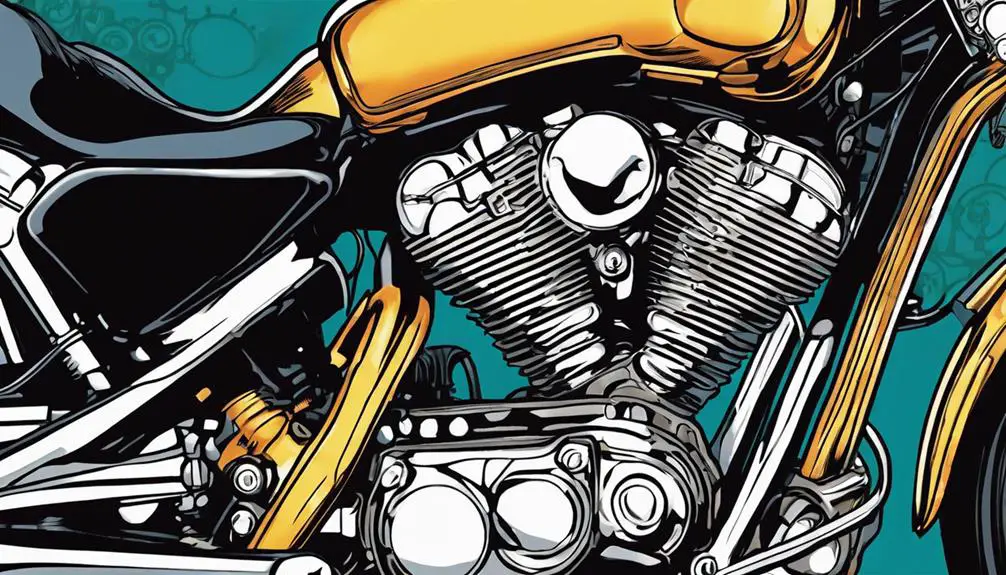
Understanding how your motorcycle's belt functions is vital for guaranteeing peak performance and longevity. The belt connects the engine to the rear wheel, transferring power efficiently to propel you forward. This system operates smoothly when everything's in sync, allowing you to feel the freedom of the open road.
When you accelerate, the belt tightens around the pulleys, converting your engine's power into motion. It's designed to withstand high speeds and harsh conditions, but it needs your attention. Routine maintenance helps you catch potential issues before they disrupt your ride.
If you feel vibrations or notice a decrease in acceleration, it could be a sign that the belt isn't doing its job. Keeping an eye on tension and alignment is essential for peak performance. You want to enjoy the thrill of the ride without worrying about mechanical failures.
In essence, understanding your motorcycle's belt helps you embrace the true spirit of freedom. The more you know about its functionality, the better equipped you'll be to anticipate needs and replace it when necessary. This knowledge guarantees your bike remains a reliable companion on your journey to liberation.
Recognize Wear Indicators
To keep your motorcycle running smoothly, you need to recognize the wear indicators on your belt.
Regular visual inspections can help you spot any signs of damage, while listening for unusual noises can alert you to potential issues.
Staying alert to these indicators will guarantee you address problems before they escalate.
Visual Inspection Techniques
Inspecting your motorcycle belt regularly helps you spot wear indicators that signal the need for replacement. Taking a moment to look closely can save you from unexpected breakdowns on the road. Here are some key visual inspection techniques to reflect on:
- Cracks and Fraying: Look for any visible cracks or frayed edges. These can indicate that your belt is losing its integrity and needs replacing.
- Discoloration: Check for any unusual discoloration. A belt that's faded or has darkened spots could be experiencing heat damage and mightn't perform as it should.
- Belt Thickness: Measure the belt's thickness. If it appears considerably thinner than when it was new, it's time to think about a replacement.
- Uneven Wear: Inspect the belt for uneven wear patterns. If you see uneven surfaces or bald spots, this could signal alignment issues or the need for a new belt.
Listen for Noises
Pay attention to any unusual sounds coming from your motorcycle, as they can reveal important wear indicators that suggest your belt might need replacement. If you hear a grinding, squeaking, or chirping noise, it's time to take action. These sounds often indicate that your belt is slipping or fraying, which can lead to bigger issues down the line.
When you're riding, listen closely while accelerating or decelerating. A sudden change in sound can signal that your belt is struggling to maintain tension. If you notice a rattling noise, it could mean the belt is loose or worn out, impacting your bike's performance.
Don't ignore these indicators. Trust your instincts; if something doesn't sound right, investigate. Ignoring these noises can lead to costly repairs and a compromised riding experience.
Your freedom on the road depends on a well-maintained motorcycle, and that includes a healthy belt.
Determine Replacement Frequency
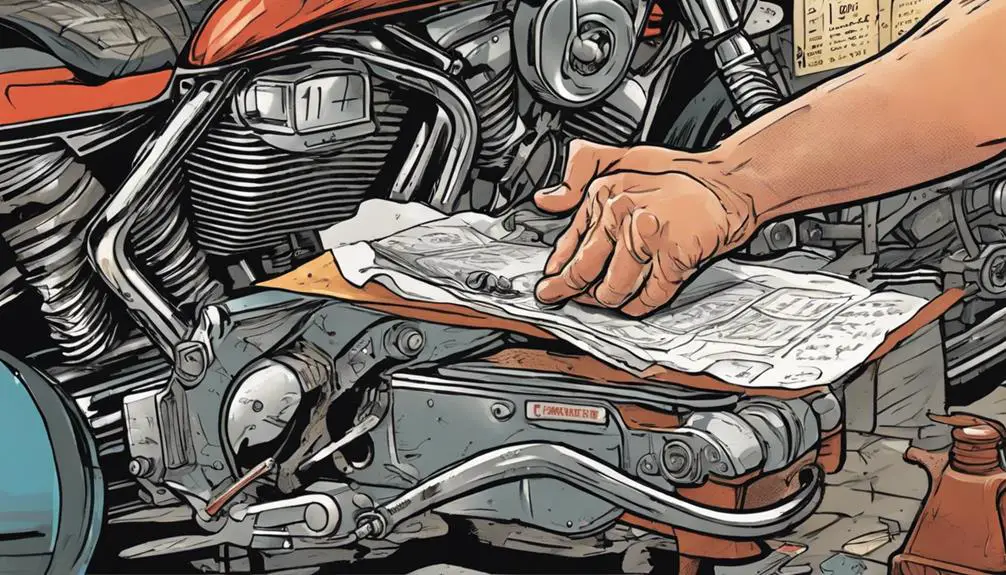
To keep your motorcycle running smoothly, it's essential to know how often to replace the belt.
Check your manufacturer's recommendations, as they provide specific guidelines for your bike model.
Additionally, consider how your riding conditions can impact the belt's lifespan, as harsher environments may require more frequent replacements.
Manufacturer Recommendations
Most manufacturers recommend replacing your motorcycle's belt every 15,000 to 20,000 miles, but it's essential to check your owner's manual for specific guidelines.
Your ride deserves the best care, and understanding the manufacturer's recommendations guarantees you stay free on the open road.
Here's a quick list to help you keep track of your belt replacement needs:
- Check Your Manual: Always refer to your owner's manual for exact mileage and specifications.
- Visual Inspections: Regularly examine your belt for signs of wear, cracks, or fraying.
- Listen for Unusual Noises: If you hear squeaking or whining sounds, it could be a sign that your belt needs replacement.
- Stay Informed: Keep up with manufacturer updates or recalls that might affect your motorcycle's performance.
Riding Conditions Impact
Riding conditions can greatly affect how often you need to replace your motorcycle's belt, so it's important to take into account factors like terrain and weather. If you're cruising on smooth highways, your belt may last longer than if you're tackling rough, rocky trails. The more strain you put on your bike, the quicker the wear and tear.
Weather plays a crucial role too. Riding in extreme heat can cause the belt to dry out and crack, while cold, wet conditions can lead to slippage and corrosion. If you often ride in harsh environments, consider checking your belt more frequently.
You should also keep an eye on your riding style. Aggressive acceleration and hard braking can put extra stress on your belt, leading to a shorter lifespan. If you love feeling the wind and freedom, remember that gentle handling can preserve your belt's health.
Ultimately, listen to your machine. If you notice unusual noises or performance issues, don't ignore them. Regularly inspect your belt based on your riding conditions, and you'll keep your motorcycle in top shape, ready for the open road ahead.
Choose Quality Replacement Parts
When replacing your motorcycle belt, prioritizing quality parts can greatly enhance performance and longevity. It's not just about fitting a new belt; it's about choosing components that resonate with your spirit of freedom.
Here's how to ascertain you're making the right choice:
- Material Matters: Opt for belts made from high-quality, durable materials that can withstand wear and tear. Look for options designed for specific riding conditions.
- Brand Reputation: Trust reputable brands known for their reliability. Research customer reviews and seek recommendations from fellow riders to find brands that deliver on their promises.
- Compatibility: Ascertain the belt you choose is compatible with your motorcycle model. A perfect fit not only enhances performance but also minimizes the risk of premature wear.
- Warranty and Support: Look for products that come with a warranty. This reflects the manufacturer's confidence in their product, and it gives you peace of mind as you ride into the horizon.
Follow Manufacturer Guidelines
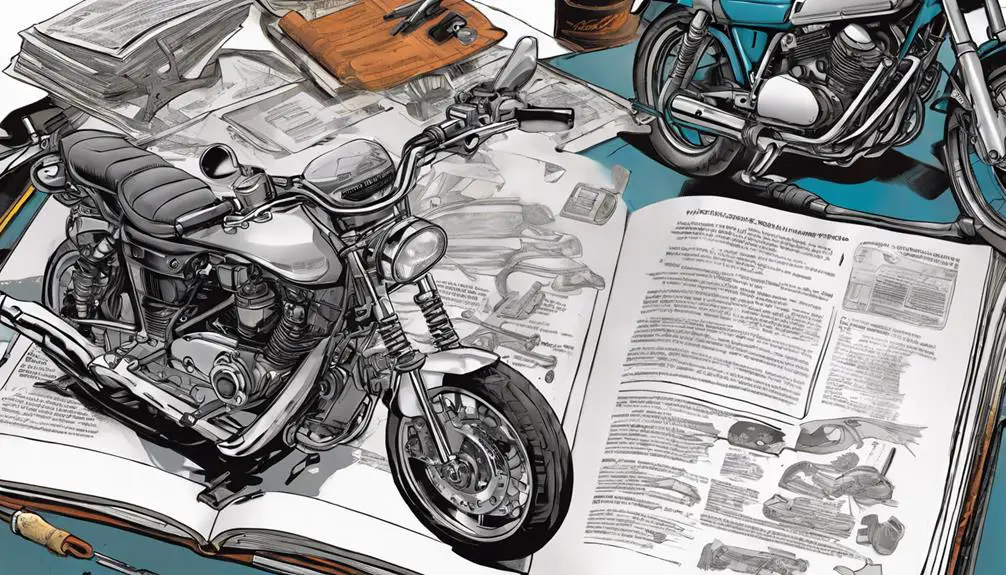
Following manufacturer guidelines guarantees that your new belt fits perfectly and performs at its best, enhancing your motorcycle's overall efficiency.
When you stick to these specifications, you're not just following rules; you're embracing the freedom of reliable performance. Each motorcycle manufacturer designs their belts with unique measurements and materials for a reason. Ignoring these details can lead to subpar performance or even mechanical failure, which stifles your ride.
Take the time to carefully read the owner's manual or consult the manufacturer's website. They'll often provide essential instructions regarding belt size, tension, and installation procedures.
This knowledge empowers you to make informed choices that keep your bike running smoothly and safely.
Inspect Other Components
When replacing your motorcycle belt, it's essential to inspect other components as well.
Check the condition of the belt, examine the pulleys and sprockets for wear, and verify the tensioner is properly aligned.
Addressing these areas can help prevent future issues and keep your ride smooth.
Check Belt Condition
Inspecting the belt condition is essential, but don't forget to check other components for wear and tear that could affect performance. When you're on the road, every part of your motorcycle plays a role in your freedom and safety. Here are some key components to inspect alongside the belt:
- Tensioner: Verify it's functioning correctly. An improperly tensioned belt can lead to slippage or excessive wear.
- Bearings: Check for smooth movement. Worn bearings can cause vibrations, impacting your ride and the longevity of your belt.
- Chain Guard: Inspect for cracks or damage. A compromised guard can expose your belt to debris, leading to premature failure.
- Frame Alignment: Verify that everything is aligned. Misalignment can create uneven wear and strain on the belt.
Taking the time to inspect these components helps you maintain peak performance and prolongs your motorcycle's lifespan.
Your ride is about liberation and adventure, so don't let mechanical issues hold you back. Embrace the journey, and verify everything is in top shape!
Examine Pulleys and Sprockets
Make sure to closely examine the pulleys and sprockets for any signs of wear or damage, as they play an important role in the efficiency of your motorcycle's belt system. If these components aren't in top shape, your ride won't feel as smooth or powerful, and you could risk breakdowns that hinder your freedom on the road.
Look for grooves, cracks, or any irregularities. A worn pulley can cause slipping and ultimately lead to belt failure, while damaged sprockets can misalign the entire system. Don't just glance—get up close and personal. Use your hands to feel for any rough edges that mightn't be visible to the eye.
Also, pay attention to the surface where the belt contacts the pulleys. It should be smooth and free of debris. If you find anything amiss, it's important to replace these parts before they cause further damage.
After all, your motorcycle is more than just a machine; it's your gateway to adventure. Keeping these components in check means more time riding and less time worrying. Embrace the open road by ensuring your pulleys and sprockets are up to the task!
Inspect Tensioner Alignment
After verifying the pulleys and sprockets are in good condition, check the alignment of the tensioner to maintain ideal belt performance. A misaligned tensioner can lead to premature belt wear and negatively impact your ride.
Here's how to inspect it effectively:
- Visual Inspection: Look for any obvious signs of misalignment, such as uneven wear on the belt or tensioner.
- Measure Alignment: Use a straight edge or alignment tool to confirm that the tensioner is parallel to the pulleys.
- Check Tension: Verify the tensioner applies consistent pressure to the belt. A loose tensioner can cause slippage, while a tight one can lead to unnecessary strain.
- Listen for Noise: Start your bike and listen for unusual sounds from the tensioner area. Any grinding or squeaking could mean it's time for a replacement.
Check for Proper Tension
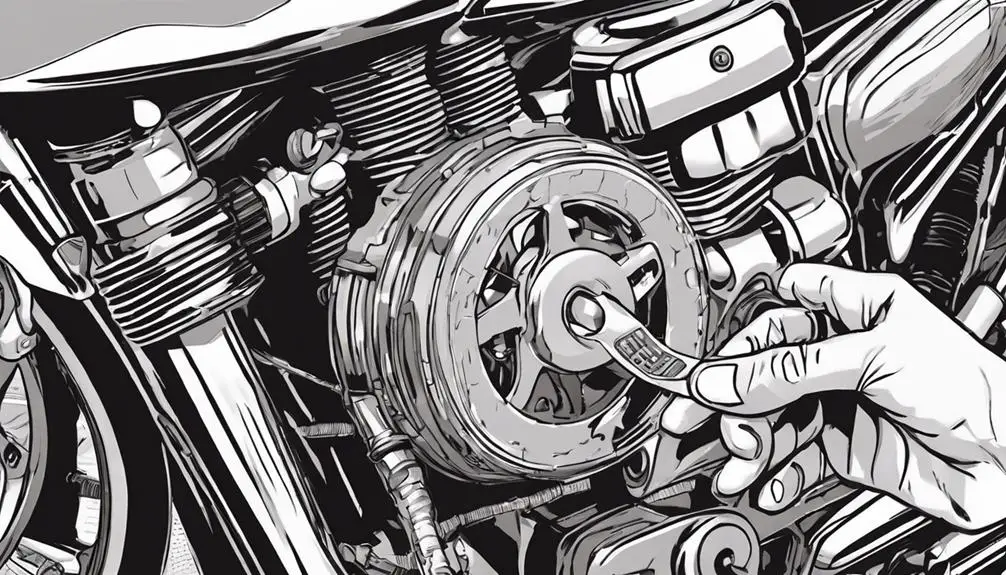
To guarantee peak performance, you should regularly check the tension of your motorcycle belt. A properly tensioned belt guarantees smooth operation and maximizes your ride's efficiency. If the belt's too loose, it can slip, causing power loss and potential damage. Conversely, a belt that's too tight can lead to premature wear and tear on your components.
Start by referring to your motorcycle's manual for the recommended tension specifications. Use a tension gauge or a simple finger test to assess the belt's tension. Press down on the belt midway between the pulleys; it should have a slight give but shouldn't feel overly slack. If you notice it's out of spec, make adjustments as needed.
While you're at it, inspect the belt for any signs of fraying or damage. A healthy belt is vital for your freedom on the road. Remember, your bike's performance impacts your riding experience, so don't overlook this important maintenance task.
Consider Professional Help
Sometimes, tackling motorcycle belt replacement on your own can lead to complications, so considering professional help might be the smartest choice. While you may feel empowered to do it yourself, there are moments when expertise can save you time, money, and stress.
Here are some reasons to think about hiring a professional:
- Experience: Professionals have hands-on experience with various motorcycle models, ensuring the job is done right.
- Tools: They come equipped with specialized tools that you mightn't have, making the process smoother and faster.
- Warranty Protection: Many shops offer warranties on their work, giving you peace of mind that any issues will be addressed without extra cost.
- Time-Saving: Letting a pro handle the replacement frees you up to enjoy your rides without the hassle of troubleshooting.
Embracing the freedom of the open road means knowing when to ask for assistance.
Don't hesitate to lean on the skills of a professional; it could be the key to ensuring your motorcycle runs as it should, so you can fully enjoy every ride.
Maintain Regular Maintenance
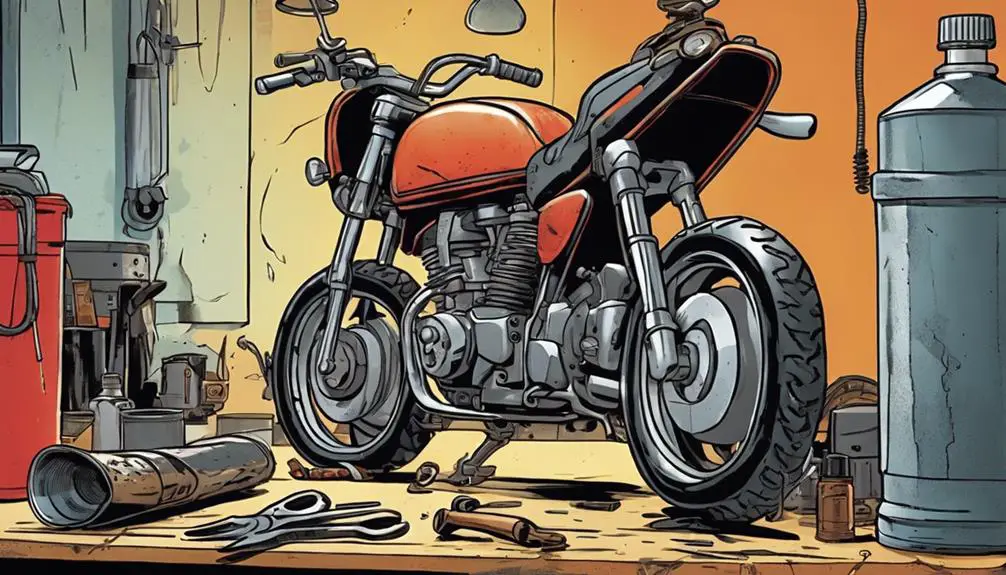
Maintaining a regular maintenance schedule is essential for extending the life of your motorcycle's belt and ensuring peak performance on the road. You want freedom on your ride, and that starts with keeping your bike in top shape.
Check your belt regularly for signs of wear, such as fraying or cracks. A quick visual inspection can save you from unexpected breakdowns and costly repairs.
Don't forget about the tension. An improperly tensioned belt can lead to slippage or premature wear. Make sure it's adjusted correctly, and if you're unsure, consult your manual or a professional.
Lubrication is key too—ensure your belt's components are well-lubricated to reduce friction and enhance performance.
Regularly change your bike's oil and filter, as dirty oil can affect not just the engine but also the belt's health.
And while you're at it, check the alignment of your belt. Misalignment can cause uneven wear and stress on the belt.
Document Replacement History
Keeping a detailed log of your motorcycle belt replacements can help you track wear patterns and anticipate future maintenance needs. This proactive approach allows you to ride with confidence, knowing your bike's performance is optimized. Don't just replace belts; document every change. Here's how to effectively maintain your replacement history:
- Date of Replacement: Record when you replaced the belt. This helps you recognize intervals and plan future replacements.
- Mileage: Note the mileage at the time of each replacement. It provides insight into how your riding style affects wear.
- Belt Condition: Take notes on the condition of the belt when replaced. Include any unusual wear patterns or signs of damage.
- Maintenance Actions: Document any related maintenance performed, like adjusting tension or inspecting other components.
Frequently Asked Questions
Can I Use a Used Belt for Replacement?
You might be tempted to use a used belt for replacement, but it's not always a wise choice. A worn belt can lead to performance issues and safety risks, jeopardizing your freedom on the road.
You deserve reliability and peace of mind during your rides. Instead, consider investing in a new belt that meets your motorcycle's specifications.
That way, you'll guarantee a smoother, safer journey while embracing the open road ahead.
Are There Specific Tools Required for Belt Replacement?
When you tackle a belt replacement, you'll need a few specific tools to get the job done right.
Grab a socket set, a torque wrench, and a belt tension gauge. You might also want pliers and a screwdriver for those pesky fasteners.
With these tools in hand, you'll be ready to liberate your motorcycle from a worn-out belt and enjoy the freedom of the open road again.
How Do I Dispose of an Old Motorcycle Belt?
When you're ready to dispose of your old motorcycle belt, consider recycling it if possible.
Check local recycling centers for guidelines on rubber and plastic materials.
If that's not an option, you can throw it in the trash, but make sure it's securely bagged to prevent litter.
Some motorcycle shops might also accept old belts, so don't hesitate to ask.
You're freeing up space while being eco-conscious!
What Are the Risks of Delaying Belt Replacement?
Delaying belt replacement can lead to serious risks. You might experience decreased performance, making your rides less enjoyable.
A worn belt can snap unexpectedly, leaving you stranded or causing potential accidents. Ignoring this maintenance task can also damage other components, leading to costly repairs.
Plus, it compromises your safety on the road. Staying proactive with belt replacements guarantees you maintain control and enjoy the freedom of riding without worry.
Don't let neglect hold you back!
Can Weather Conditions Affect Belt Lifespan?
Can weather really impact how long your belt lasts? Absolutely!
Extreme temperatures, whether scorching heat or freezing cold, can wear down your belt faster than you might think.
Rain and humidity can lead to corrosion or mold, compromising its integrity.
Plus, UV rays can cause the material to degrade.
Conclusion
In the intricate dance of motorcycle maintenance, staying attuned to your belt's needs guarantees a smooth ride.
By understanding functionality, recognizing wear, and choosing quality parts, you're not just replacing a belt; you're crafting a safer journey.
Don't overlook the rhythm of regular inspections and proper tension to keep your bike humming like a finely tuned engine.
Embrace professional help when needed, and keep a detailed history—it's your roadmap to reliability on every adventure.